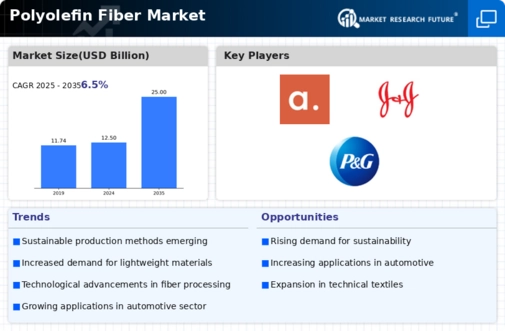Market Share
Polyolefin Fiber Market Share Analysis
In the competitive landscape of the Polyolefin Fiber Market, companies employ various market share positioning strategies to gain a competitive edge and secure their position in the industry. One prevalent strategy is differentiation, where companies aim to distinguish their products from competitors through unique features or attributes. For instance, they might focus on developing polyolefin fibers with superior strength, durability, or eco-friendly characteristics. By offering something distinct, they can target specific customer segments and command premium prices, thereby increasing their market share.
The demand for the synthetic turf at the sports fields, residential areas, and public places is propelling the market growth.
Another key strategy is cost leadership, which involves producing polyolefin fibers at the lowest possible cost without compromising quality. Companies achieving cost leadership can offer competitive pricing to customers, capturing market share through affordability. This strategy often involves streamlining production processes, optimizing supply chains, and leveraging economies of scale to minimize expenses. By undercutting competitors' prices while maintaining acceptable quality standards, firms can attract price-sensitive customers and expand their market share.
Innovation plays a crucial role in market share positioning within the Polyolefin Fiber Market. Companies invest in research and development to introduce new products or improve existing ones, staying ahead of the curve. Innovation can involve developing advanced manufacturing techniques, enhancing fiber performance, or creating novel applications for polyolefin fibers. By continuously innovating, companies can differentiate themselves, attract customers seeking cutting-edge solutions, and secure a larger market share.
Strategic partnerships and collaborations are also instrumental in market share positioning. Companies may form alliances with suppliers, distributors, or other industry players to strengthen their market presence. Such partnerships can facilitate access to new markets, distribution channels, or technologies, enabling companies to expand their reach and capture additional market share. Collaborations can also lead to synergies, where combined resources and expertise generate greater value than individual efforts, fostering growth and competitiveness.
Market segmentation is another vital aspect of market share positioning strategies in the Polyolefin Fiber Market. Companies analyze the market to identify distinct customer segments with unique needs and preferences. They then tailor their products, marketing messages, and distribution channels to effectively target each segment. By focusing on specific market segments, companies can address customer requirements more precisely, enhancing customer satisfaction and increasing market share within those segments.
Geographical expansion is a common strategy employed by polyolefin fiber manufacturers to grow their market share. Companies may enter new regions or countries with untapped potential, seeking to capitalize on emerging opportunities. Expansion into new markets requires careful market research, understanding local regulations, and adapting products to meet regional preferences and requirements. By expanding geographically, companies can access larger customer bases, diversify their revenue streams, and strengthen their overall market position.
Furthermore, customer-centric strategies are essential for gaining and retaining market share in the Polyolefin Fiber Market. Companies prioritize customer needs and preferences, offering tailored solutions and excellent customer service. By building strong relationships with customers, companies can foster loyalty and advocacy, securing repeat business and positive word-of-mouth referrals. Additionally, gathering feedback from customers allows companies to continuously improve their products and services, staying ahead of competitors and maintaining market share.






Leave a Comment